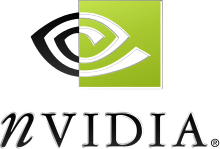NV1
The Nvidia NV1, manufactured by SGS-Thomson Microelectronics under the model name STG2000, was a multimedia PCI card released in May 1995. It was sold to retail by Diamond as the Diamond Edge 3D.
 The original Nvidia logo | |
| Release date | May 22, 1995[1] |
|---|---|
| Codename | NV1 |
| API support | |
| Direct3D | none |
| History | |
| Successor | RIVA 128 |
The NV1 featured a complete 2D/3D graphics core based upon quadratic texture mapping, VRAM or FPM DRAM memory, an integrated 32-channel 350 MIPS playback-only sound card, and a Sega Saturn compatible joypad port. As such, it was intended to replace the 2D graphics card, Sound Blaster-compatible audio systems, and 15-pin joystick ports, then prevalent on IBM PC compatibles.
Putting all of this functionality on a single card led to significant compromises, and the NV1 was not very successful in the market. A modified version, the NV2, was developed in partnership with Sega for the Sega Dreamcast, but ultimately dropped. Nvidia's next stand-alone product, the RIVA 128, focussed entirely on 2D and 3D performance and was much more successful.
History
Several Sega Saturn games were converted to NV1-compatible formats on the PC such as Panzer Dragoon and Virtua Fighter Remix. However, the NV1 struggled in a market place full of several competing proprietary standards, and was marginalized by emerging Triangle polygon-based 2D/3D accelerators such as the low-cost S3 Graphics ViRGE, Matrox Mystique, ATI Rage, and Rendition Vérité V1000 among other early entrants. It ultimately did not sell well, despite being a promising and interesting device.[2]

NV1's biggest initial problem was its cost and overall quality. Although it offered credible 3D performance, its use of quadratic surfaces was anything but popular, and was quite different than typical polygon rendering. The audio portion of the card received merely acceptable reviews, with the General MIDI receiving lukewarm responses at best (a critical component at the time due to the incredible sound quality produced by competitors). The Sega Saturn console was a market failure compared to Sony's PlayStation or Sega's earlier Sega Genesis, and so the unique and somewhat limiting support of these gamepads was of limited benefit. Nvidia, by integrating all of these usually separate components, raised their costs considerably above what they would have been if the card had been designed solely for 3D acceleration.
During the NV1's release timeframe, the transition from VLB/ISA (486s) to PCI (Pentiums and late model 486 boards) was taking place, and games often used MIDI for music because PCs were still generally incapable of large-scale digital audio playback due to storage and processing power limitations. Reaching for the best music and sound quality, and flexibility with MS-DOS audio standards, often required 2 sound cards be used, or a sound card with a MIDI daughtercard connector. Additionally, NV1's 2D speed and quality were not competitive with many of the high-end systems available at the time, especially the critical-for-games DOS graphics speed. Many customers were simply not interested in replacing their often-elaborate system setups with an expensive all-in-one board and so the heavy integration of NV1 hurt sales simply through inconvenience.

Market interest in the product quickly ended when Microsoft announced the DirectX specifications, based upon triangle polygon rendering. This release by Microsoft of a major industry-backed API that was generally incompatible with NV1 ended Nvidia's hopes of market leadership immediately. While demos of quadratic rendered round spheres looked good, experience had proved working with quadratic texture maps was extremely difficult. Even calculating simple routines was problematic. Nvidia did manage to put together limited Direct3D support, but it was slow and buggy (software-based), and no match for the native triangle polygon hardware on the market.
Subsequent NV1 quadratic-related development continued internally as the NV2.
3D games that supported NV1
- Battle Arena Toshinden
- Daytona USA (Japanese releases)
- Descent: Destination Saturn
- NASCAR Racing
- Panzer Dragoon
- Sonic X-treme (cancelled)
- Virtua Fighter Remix
- Virtua Cop
References
- Nvidia Corporation (May 22, 1995). "Multimedia Accelerator From NVIDIA Corporation Transforms PC Into The Ultimate Multimedia Machine" (Press release). Archived from the original on November 12, 1996. Retrieved April 14, 2020.
- Lazy Game Reviews (2014-09-18), LGR - Oddware - Diamond Edge 3D (nVidia NV1+Sega Saturn), retrieved 2016-05-11